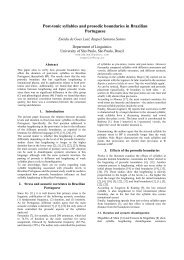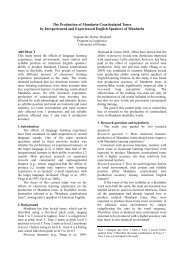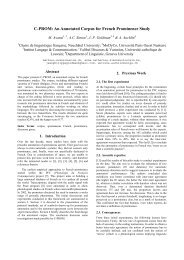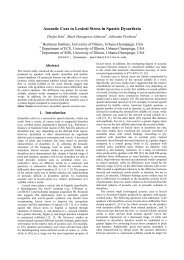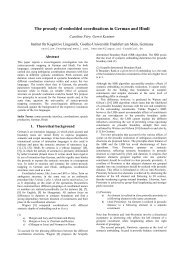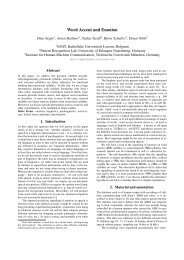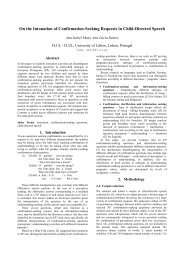Single vs. double focus in English statements and yes/no questions
Single vs. double focus in English statements and yes/no questions
Single vs. double focus in English statements and yes/no questions
You also want an ePaper? Increase the reach of your titles
YUMPU automatically turns print PDFs into web optimized ePapers that Google loves.
Figure 6: Max F 0 ’s of the <strong>in</strong>itial, medial, <strong>and</strong> f<strong>in</strong>al words <strong>in</strong><br />
<strong>statements</strong> <strong>and</strong> <strong>questions</strong> under different <strong>focus</strong> conditions.<br />
As shown <strong>in</strong> Figure 6 <strong>and</strong> revealed <strong>in</strong> the repeated measures<br />
ANOVA, max F 0 ’s of the three key words vary significantly<br />
with its position (F(2,6) = 15.99, p = 0.0039), sentence type<br />
(F(1,3) = 10.75, p = 0.0465), <strong>and</strong> <strong>focus</strong> (F(6,18) = 6.68, p =<br />
0.0008). That is, the <strong>in</strong>itial key word (mean = 93.7 st) is <strong>in</strong><br />
general higher <strong>in</strong> max F 0 than the f<strong>in</strong>al key word (mean = 92.6<br />
st), which is <strong>in</strong> turn higher <strong>in</strong> max F 0 than the medial key word<br />
(mean = 91.9 st). Furthermore, the three key words generally<br />
have higher max F 0 ’s <strong>in</strong> <strong>questions</strong> (mean = 95.0 st) than <strong>in</strong><br />
<strong>statements</strong> (mean = 90.5 st), <strong>and</strong> they also have different max<br />
F 0 ’s under different <strong>focus</strong> conditions. The two-way <strong>and</strong> threeway<br />
<strong>in</strong>teractions between the three factors are all statistically<br />
significant (sentence type × <strong>focus</strong>: F(6,18) = 12.23, p <<br />
0.0001; sentence type × key-word position: F(2,6) = 19.85, p =<br />
0.0023; <strong>focus</strong> × key-word position: F(12,36) = 12.08, p <<br />
0.0001; sentence type × <strong>focus</strong> × key-word position: F(12,36) =<br />
3.07, p = 0.0045). The follow<strong>in</strong>g post-hoc analyses reached<br />
statistical significance (p < 0.05).<br />
Firstly, the <strong>in</strong>itial word has significantly greater max F 0 <strong>in</strong><br />
<strong>questions</strong> than <strong>in</strong> <strong>statements</strong> under <strong>in</strong>itial, <strong>in</strong>itial + f<strong>in</strong>al, <strong>and</strong><br />
<strong>in</strong>itial + medial <strong>focus</strong> conditions (Fig. 6A). This is due to the<br />
pitch target shift of the stressed syllable <strong>in</strong> the <strong>in</strong>itial word<br />
from [high] or [fall] <strong>in</strong> <strong>statements</strong> to [rise] <strong>in</strong> <strong>questions</strong>, as<br />
mentioned earlier. For the question-<strong>in</strong>itial word, its max F 0 is<br />
significantly greater when it is <strong>focus</strong>ed (under <strong>in</strong>itial, <strong>in</strong>itial +<br />
medial, <strong>and</strong> <strong>in</strong>itial + f<strong>in</strong>al <strong>focus</strong> conditions) than when it is<br />
pre-<strong>focus</strong> (under medial, f<strong>in</strong>al, <strong>and</strong> neutral <strong>focus</strong> conditions),<br />
demonstrat<strong>in</strong>g both on-<strong>focus</strong> pitch range expansion <strong>and</strong> pre<strong>focus</strong><br />
pitch range neutralization. Furthermore, the question<strong>in</strong>itial<br />
word under <strong>in</strong>itial + f<strong>in</strong>al <strong>and</strong> <strong>in</strong>itial + medial <strong>focus</strong><br />
conditions also has significantly higher max F 0 than when it is<br />
under the medial + f<strong>in</strong>al <strong>focus</strong> condition, aga<strong>in</strong> demonstrat<strong>in</strong>g<br />
both on-<strong>focus</strong> pitch range expansion <strong>and</strong> pre-<strong>focus</strong> pitch range<br />
neutralization.<br />
Secondly, for the medial word (Fig. 6B), its max F 0 is<br />
significantly greater <strong>in</strong> <strong>questions</strong> than <strong>in</strong> <strong>statements</strong> when it is<br />
post-<strong>focus</strong> (under <strong>in</strong>itial <strong>and</strong> <strong>in</strong>itial + f<strong>in</strong>al <strong>focus</strong> condition), or<br />
on-<strong>focus</strong> (under medial, <strong>in</strong>itial + medial, <strong>and</strong> medial + f<strong>in</strong>al<br />
<strong>focus</strong> conditions). This is either due to post-<strong>focus</strong> pitch range<br />
difference between <strong>statements</strong> (compressed <strong>and</strong> lowered) <strong>and</strong><br />
<strong>questions</strong> (compressed <strong>and</strong> raised) after the <strong>in</strong>itial <strong>focus</strong>, or the<br />
pitch target shift of the stressed syllable <strong>in</strong> the medial word<br />
between <strong>statements</strong> ([high] or [fall]) <strong>and</strong> <strong>questions</strong> ([rise]). For<br />
the statement-medial word, its max F 0 is significantly greater<br />
when it is <strong>focus</strong>ed (under medial, <strong>in</strong>itial + medial, <strong>and</strong> medial<br />
+ f<strong>in</strong>al <strong>focus</strong> conditions) than when it is post-<strong>focus</strong> (under<br />
<strong>in</strong>itial <strong>and</strong> <strong>in</strong>itial + f<strong>in</strong>al <strong>focus</strong> conditions), demonstrat<strong>in</strong>g both<br />
on-<strong>focus</strong> pitch range expansion <strong>and</strong> post-<strong>focus</strong> pitch range<br />
suppression <strong>in</strong> <strong>statements</strong>. The question-medial word has<br />
significantly higher max F 0 when it is post-<strong>focus</strong> (under <strong>in</strong>itial<br />
<strong>focus</strong>) or on-<strong>focus</strong> (under medial, <strong>in</strong>itial + medial, <strong>and</strong> medial<br />
+ f<strong>in</strong>al <strong>focus</strong> conditions) than when it is pre-<strong>focus</strong> (under f<strong>in</strong>al<br />
<strong>and</strong> neutral <strong>focus</strong> conditions), aga<strong>in</strong> due to the tri-zone pitch<br />
range modification of <strong>focus</strong> <strong>in</strong> <strong>questions</strong>. Interest<strong>in</strong>gly, the<br />
question-medial word also has significantly higher max F 0<br />
when it is under <strong>in</strong>itial <strong>focus</strong> than when it is under the <strong>in</strong>itial +<br />
f<strong>in</strong>al <strong>focus</strong>, suggest<strong>in</strong>g that there is post-<strong>focus</strong> pitch range<br />
suppression after <strong>focus</strong> 1 of <strong>double</strong> <strong>focus</strong> <strong>in</strong> <strong>questions</strong>.<br />
Thirdly, for the f<strong>in</strong>al word (Fig. 6C), its max F 0 is<br />
significantly greater <strong>in</strong> <strong>questions</strong> than <strong>in</strong> <strong>statements</strong> under all<br />
<strong>focus</strong> conditions. This is either due to post-<strong>focus</strong> pitch range<br />
difference between <strong>statements</strong> (compressed <strong>and</strong> lowered) <strong>and</strong><br />
<strong>questions</strong> (compressed <strong>and</strong> raised) after the <strong>in</strong>itial/medial<br />
<strong>focus</strong>, or the pitch target shift of the stressed syllable <strong>in</strong> the<br />
f<strong>in</strong>al word between <strong>statements</strong> ([high] or [fall]) <strong>and</strong> <strong>questions</strong><br />
([rise]).<br />
F<strong>in</strong>ally, as shown <strong>in</strong> Fig. 6A-C, each of the three key<br />
words does <strong>no</strong>t have significantly different max F 0 when it is<br />
s<strong>in</strong>gle-<strong>focus</strong>ed than when it is <strong>double</strong>-<strong>focus</strong>ed <strong>in</strong> either<br />
<strong>statements</strong> or <strong>questions</strong>. That is, the on-<strong>focus</strong> pitch range<br />
expansion is similar <strong>in</strong> magnitude across s<strong>in</strong>gle <strong>and</strong> <strong>double</strong><br />
<strong>focus</strong> conditions.<br />
3.2.2. Duration<br />
Figure 7: Durations of the <strong>in</strong>itial, medial, <strong>and</strong> f<strong>in</strong>al words <strong>in</strong><br />
<strong>statements</strong> <strong>and</strong> <strong>questions</strong> under different <strong>focus</strong> conditions.<br />
As shown <strong>in</strong> Figure 7 <strong>and</strong> revealed <strong>in</strong> the repeated measures<br />
ANOVA, durations of the three key words vary significantly<br />
with <strong>focus</strong> (F(6,18) = 13.68, p < 0.0001), but <strong>no</strong>t with its<br />
position (F(2,6) = 2.37, p = 0.17) or sentence type (F(1,3) =<br />
0.02, p = 0.90). That is, the three key words have different<br />
durations under different <strong>focus</strong> conditions, but their durations<br />
are similar across key-word positions <strong>and</strong> sentence types. In<br />
addition, the two-way <strong>in</strong>teraction between <strong>focus</strong> <strong>and</strong> key-word<br />
position is also statistically significant (F(12,36) = 14.60, p <<br />
0.0001), which will be expla<strong>in</strong>ed by the follow<strong>in</strong>g post-hoc<br />
analyses (only comparisons that reached statistical<br />
significance, p < 0.05, are shown below).



